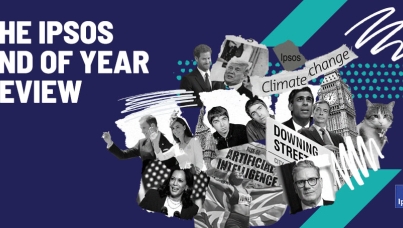Despite continued pressures on the NHS, maternity service users report an improved experience in the 2023 Maternity Survey
What is the Maternity Survey?
The Maternity Survey1, commissioned by the Care Quality Commission (CQC), started in 2007 and the 2023 survey is the tenth carried out to date. It looks at the experiences of maternity service users who gave birth at an NHS trust in England in February 2023. The survey also collects information about patients’ demographics (including characteristics protected by the Equality Act 20102, such as age, long-term condition, religion and ethnicity), in order to understand differences in care. This year, CQC trialled an ethnicity booster, inviting additional service users from ethnic minority backgrounds to complete the survey to allow for additional analysis by ethnicity.
The year leading up to the 2023 Maternity Survey was significant for maternity services.
The 2023 Maternity Survey was sent to all service users who gave birth at one of 121 participating NHS trust in England in February 2023, and some who gave birth in January and March 2023. The year leading up to this saw remaining Covid-19 restrictions lifted, and maternity services returning to their pre-pandemic approach.
At the same time, in February 2022, the government introduced a Maternity Disparities Taskforce3, whose goal is to explore inequalities in maternity care and identify how the government can improve outcomes for those from ethnic minority communities and those living in deprived areas. There has also been a rise in the annual maternity budget, which was increased by £165 million since 20214. Against the backdrop of a series of concerns raised regarding the quality and safety of maternity services (such as the Ockenden review), these measures are needed now more than ever, as services recover from the pandemic and address long-term shortcomings.
The survey demonstrated that antenatal services have mostly recovered to pre-pandemic levels.
The Maternity Survey has been running since 2013, showing continuous improvement of maternity services in England. In 2019, the last year the survey ran before the pandemic, service users’ satisfaction was at its highest. Therefore, it’s important to note that when comparing this year’s results to 2019, we are not only comparing the services to pre-pandemic levels, but also to some of the highest results since tracking began.
That said, all thirteen of the comparable indicators of quality of antenatal care have improved since 2022. Service users reported improved communication with their healthcare professionals, with more than four in five (81%) indicating that they were ’always’ given enough time to ask questions or discuss their pregnancy during their antenatal appointments, the highest proportion since the question was introduced in 2013. With the Covid-19 restrictions lifted, the prevalence of video and phone antenatal appointments diminished to zero and eight per cent respectively (down from 2% and 41% during the pandemic in 2021). All respondents reported having face-to-face appointments – a potential reason for the improvement in their experiences of communication with staff.
Similarly, the majority of service users reported that their midwives ‘always’ listened to them during their check-ups (83%, up from 79% in 2021, and in line with 2019), and that they were ‘always’ involved in decisions about their care (80%, up from 77% in 2021). Most importantly, almost nine in ten (87%) reported that if they raised a concern during their antenatal care, they felt that it was taken seriously.
This high quality of care reported by service users was underpinned by their confidence and trust in the staff caring for them, and their perception of being treated well, with 87% reporting ‘always’ being treated with respect and dignity.
On the other hand, labour and birth and postnatal services are recovering more slowly.
The results of the 2023 Maternity Survey indicate that labour and birth and postnatal services have been recovering from the pandemic, although not as quickly as antenatal services. There have been improvements in 24 of 35 indicators of quality of care during these stages of pregnancy journey, (where they are comparable to last year). The remaining 10 saw no significant changes and 1 indicator showed a decline.
One area showing stalled recovery is service users’ confidence and trust in the staff caring for them during labour and birth. Whilst a high proportion still report positive experiences, with more than three-quarters (78%) reporting they ‘definitely’ had confidence and trust in staff caring for them, this remains below pre-pandemic levels (84% in 2019). Similarly, the proportion of service users reporting ‘always’ being treated with kindness and understanding (72%) has not recovered to the pre-pandemic level (76% in 2019).
Additionally, service users report poorer access to advice at later stages of their pregnancy journey. For example, of those who were induced, three in ten (31%) maternity service users felt that they were not given appropriate information and advice on the risks associated with induced labour, and nearly one in five (19%) were not given appropriate information and advice on its benefits. This trend continues after the birth, with almost a quarter (24%) of service users reporting that they did not have an opportunity to ask questions about their labour and birth after their baby was born, and one in five (20%) reporting that when they raised a concern during labour and birth, they felt it was not taken seriously. Again, this is in contrast to pre-pandemic levels, when only 16% of respondents reported this issue. Overall, this shows that maternity services during and after labour and birth have not yet recovered from the pandemic.
Lack of staff is a key barrier to the post-pandemic recovery of maternity services.
One potential explanation for the slow recovery of maternity services could be the lack of maternity staff. This is evident in the results of the 2023 Maternity Survey, especially during labour and birth and care after birth. As outlined above, service users report lower confidence in staff and poorer access to advice than before the pandemic. Only two-thirds (64%) report that they were ’always’ able to get a member of staff to help them when they needed it during labour and birth (down from 72% in 2019). This drops to a little over half (55%) when in hospital after birth (down from 62% in 2019). A similar trend continues once service users leave hospital, with a third (32%) of respondents reporting that they would have liked to have seen or spoken to a midwife ‘more often’ after the birth.
Having had brilliant care for antenatal and birth I was shocked at the poor care I received on the postnatal ward. I was weak and vulnerable after a difficult birth and was left for hours to care for myself despite not being in a position to do so.
These results come at a time when the Royal College of Midwives estimates a shortfall of 2,500 maternity staff in England5. This issue is a growing public concern, as demonstrated in the 2023 Heath Foundation Policy Programme Report6. It shows that the public think the pressure and workload on NHS staff has gotten worse over the past 12 months and should be prioritised moving forward. This is echoed by the NHS Confederation’s recent qualitative research which revealed that the public would prioritise increasing NHS staffing numbers above all other potential areas of action7.
A critical area affected by staff shortages is ‘Continuity of carer’.
Continuity of carer means that a service user receives their care during and after the pregnancy from one midwife or a small group of midwives. It was recommended in 2016 by Better Births8 and introduced as a commitment by the 2019 NHS Long Term Plan9, which recognised that it has been shown to improve service users’ experience and outcomes, especially for those from ethnic minority or vulnerable backgrounds.
The reason why everything went smoothly comparing to the first birth I had at the [hospital] was due to having the same midwife which was a student midwife that looked after me and my little one antenatally, during labour , birth and postnatal. Having that one point of contact was much more easy to communicate my needs
However, on 21st September 2022, NHS England announced there would no longer be a target date for maternity services to delivery Midwifery Continuity of Carer due to continued maternity staff shortages10. They indicated that this change in approach will remain in place until maternity services in England can demonstrate sufficient staffing levels to do so.
The above shift in NHS targets is reflected in the results of the 2023 Maternity Survey. During antenatal checkups, 61% of service users reported speaking to the same midwife ‘all’ or ‘some’ of the time. However, this figure drops significantly at later stages of care. During labour and birth, less than one in five (18%) respondents reported that their labour and birth midwife/midwives had also been involved in their antenatal care, and only 28% of respondents reported that the midwives who cared for them postnatally were also involved in their antenatal care. Notably, the majority (59%) of service users reported that they did not have the same midwives at any stage of their care journey.
I did not see my 'assigned' midwife once during my antenatal care. Whilst I did for the most part then see the same midwife she was never fully engaged in my care as she was always covering rather than owning me as her patient.
In conclusion, the 2023 Maternity Survey shows that overall, services are recovering from the pandemic, but there are challenges which need to be addressed to speed up the process.
Maternity care services have faced increased focus and scrutiny over recent years. It is promising to see that antenatal care appears to have recovered to pre-pandemic levels, with service users reporting improved access to advice and information, and better experiences with staff. However, high levels of satisfaction with maternity care seem to stall along the care journey, with ongoing staffing issues as one potential reason for this.
Understandably, there is no quick fix to staff recruitment and retention issues in the NHS. The 2023 Maternity Survey results serve to reinforce other calls for investment in a long-term workforce plan to help tackle ongoing staffing issues across the NHS. This additional evidence emphasises the importance of workforce planning, including a focus on recruitment and retention of maternity staff, which could lead to improvements across the board. This was recently addressed by the NHS Long Term Workforce plan11 published in June 2023, which aims to diminish these existing challenges by focusing on recruitment and retention of staff, and working in new ways to improve staff experience and, ultimately, patient care.
Technical note
- Ipsos coordinates the Maternity Survey on behalf of the CQC. NHS Trusts draw a sample of all patients, aged 16 or over, who had given birth during February 2023. If there were fewer than 300 maternity service users within an NHS trust who gave birth in February 2023, then births from January were included.
- Those Trusts who could compile a sample of minimum 300 from February 2023, additionally sampled all service users from ethnic minority backgrounds who gave birth at their
- Trust in January and March 2023. This ethnicity booster was piloted as part of 2023 Maternity Survey to provide greater detail at the analysis stage.
- The survey was conducted using a mixed methods approach, combining online and paper questionnaire modes. A total of 25,515 patients responded to the survey (an adjusted response rate of 41%) and fieldwork took place between May 2023 and August 2023.
- Results for the Maternity Survey 2023 are comparable with results from 2013, 2015, 2017, 2018, 2019, 2021, and 2022 but not with results from years prior to 2013 due to a change in survey methodology.
- Further technical information and the full survey results can be found on the CQC website (https://www.cqc.org.uk/publications/surveys).






